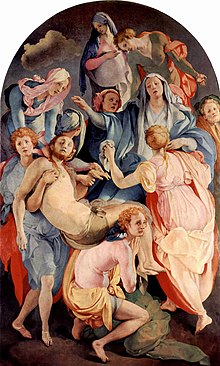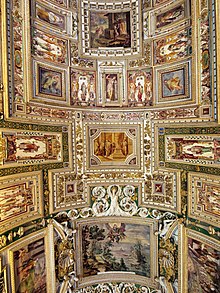Mannerism
![]()
The title of this article is ambiguous. For other meanings, see Mannerism (disambiguation).
Mannerism (from Italian maniera' "manner", "style", "manner") is an art-historical term for a style or epoch that extends roughly in the period between 1520 (Raphael's death) and 1600, outside Italy even after 1600. Mannerism was originally based on the idea that an artist should develop and emphasize his very own style, the maniera. In doing so, all technical possibilities are exhausted to an extreme design.
Depending on the definition, it is a form of the late Renaissance or a transitional style between the Renaissance and the Baroque that originated in Italy, with centers in Rome and Florence. Mannerist works were produced especially in painting, sculpture, and architecture, but also in literature and music. Literary works can generally be classified as Mannerist if they were written between the mid-16th century and 1630.
Among the most famous Mannerists are the School of Fontainebleau in France, Giovanni da Bologna, most of the Dutch Romanists, and the artists at the court of Emperor Rudolph II in Prague, including Jan Vermeyen, Adrian de Vries, Ottavio Miseroni (1567-1624), Bartholomäus Spranger, Hans von Aachen, and Joseph Heintz (so-called Rudolphine art).
In addition to its art-historical meaning as a designation for an era and a style, the term "mannered" is generally used pejoratively to describe an action, attitude, or manner of speaking that is perceived as artificial, stilted, pathetic, or pompous.

Jacopo Pontormo: Deposition of Christ from the Cross
Term
The Italian term maniera in the sense of an individual style or epoch (maniera greca = Greek manner) can already be found at the end of the 14th century by Cennino Cennini and in the 15th century by Ghiberti.
In the 16th century, Pietro Aretino called the attainment of artistic authenticity maniera nuova, and Giorgio Vasari described the style of the late Michelangelo, from which his own was derived, as maniera moderna, through which even antiquity - the previous pinnacle of artistic development - had been overcome. Vasari associated the term with a positive evaluation and the demand that an important artist develop (or possess) his own distinctive maniera. In
1557, Lodovico Dolce also used the term in a negative sense in reference to Michelangelo, whom he accused of having developed a maniera that was only a "bad exercise" and merely served to demonstrate all kinds of difficulties.
In the Baroque era, the concept of maniera and the works of sixteenth-century artists influenced by mannerism underwent an intense devaluation, among others by Bellori; manierata (= mannered) was now used to describe, for example, a contrived, unnatural-looking style of painting. In this sense, the Italian historian Luigi Lanzi first used the terms "mannerism" and "mannerists" in 1792, also in reference to Giorgio Vasari's work.
In the 19th century, Jacob Burckhardt took up the term again and was the first to introduce Mannerism as an art historical epoch term. Even in the 20th century, the scope of Mannerism was still disputed. and in the first third of the 20th century it was regarded, especially by German art historians, as an "expression of a spiritualization opposed to nature" and of an artistic subjectivity that eluded fixed norms. Italian art historians, on the other hand, emphasized the search for formal elegance, while Johann Fischart emphasized imagination and inventiveness, recognizing them also in the work of northern European painters, such as Hans Baldung Grien.
In his book Die Welt als Labyrinth. Manier und Manie in der europäischen Kunst (Mannerism and Mania in European Art), Gustav René Hocke attempted to apply the concept of Mannerism to a more comprehensive phenomenon, both stylistically and in terms of epoch, namely that of the "decentered subject of modernity". Thus, in a sense, Mannerism is the countercurrent to Classicism. In his opinion, Mannerist art continues to exist uninterruptedly in individual lifeworks up to the present. In 1964, Robert Klein spoke of an "art of art" and also extended the concept far beyond the actual epoch of Mannerism.
History and prerequisites
The first Mannerist tendencies can already be seen between 1515 and 1525 in Rome and Florence, among others in the works of Raphael (late work) and Michelangelo; from about 1520 onwards it developed in several phases and from about 1550-60 onwards can be regarded as the main current of the late Renaissance.
Its emergence coincides with religious, intellectual, political and economic upheavals and crises in Italy and Europe: the formerly bourgeois Medici family came back to power in Florence and rose to the nobility; the discovery of America in 1492 changed the previous view of the world and the Mediterranean trade, which was important for Italy, lost much of its importance; instead, Habsburg Spain rose to become a world power; an enormous shock for the whole of Europe was the Reformation triggered by Luther, with all its consequences such as religious wars, a council in Trent that lasted for decades and the ensuing Counter-Reformation. In 1527 the situation escalated when Spanish, Italian and German mercenaries in Habsburg service attacked Rome, plundered and imprisoned Pope Clement VII (Sacco di Roma).
According to some art historians, Mannerist artists, under the impression of these events, came to believe that the Renaissance program of glorifying the beauty of nature through art was mistaken, and that instead nature was to be overcome and redeemed through art. As before in the Renaissance, Neoplatonic, Gnostic and alchemical thoughts also played a role.
On the other hand, Mannerist art - like 16th-century art in general - is a distinctly courtly art that was put at the service of princely representation, including with the help of spectacular temporary festive settings. Here, as in interior decoration and arts and crafts, Mannerism tended towards spectacular splendour (see illustration).
While the Renaissance was still a mainly Italian cultural achievement, Mannerism was perhaps the first European art movement ever. Flemings in particular (Giambologna, Stradanus) moved to Italy to learn and work there, bringing their views of art with them and enriching the late phase of Mannerism (and Renaissance) (see also: Romanism). Woodcuts, and later copperplate engravings, played an important role, circulating throughout Europe. In particular, the works of Dürer were thus made known and taken up in Italy.
From the late 16th century onwards, other views of art increasingly competed with the Mannerist, above all the Classicist tendency with the Carracci brothers as the main representatives and pioneers of the Baroque (later represented in art theory by Giovanni Pietro Bellori, for whom the work of Nicolas Poussin was exemplary), and a Realist or even Naturalist with Caravaggio and his successors.
Since it has been customary outside Italy up to the present to generally and undifferentiatedly associate the adoption of features of Italian art in the 16th century with the term "Renaissance", a clear linguistic demarcation between the two terms (late) Renaissance and Mannerism is difficult in practice; for example, some Mannerist-influenced objects are proudly presented in local patriotic tradition as "the largest Renaissance hall in ..." or "the most important Renaissance building in ...". In addition, there are buzzword-like terms such as "Weser Renaissance" or "Antwerp Mannerists", which were introduced by individual art historians and have since become established, but which also undermine a correct definition: The Weser Renaissance is, by and large, actually Mannerism, while the Antwerp Mannerists are a group of painters who stand in the late Gothic tradition of Dutch painting, with transitional tendencies to the Renaissance.

Detail of the Mannerist ceiling decoration of paintings, grotesques and stucco by Girolamo Muziano and Cesare Nebbia and others in the Galleria delle carte geografiche of the Vatican Palace (ca. 1580-90)
Search within the encyclopedia